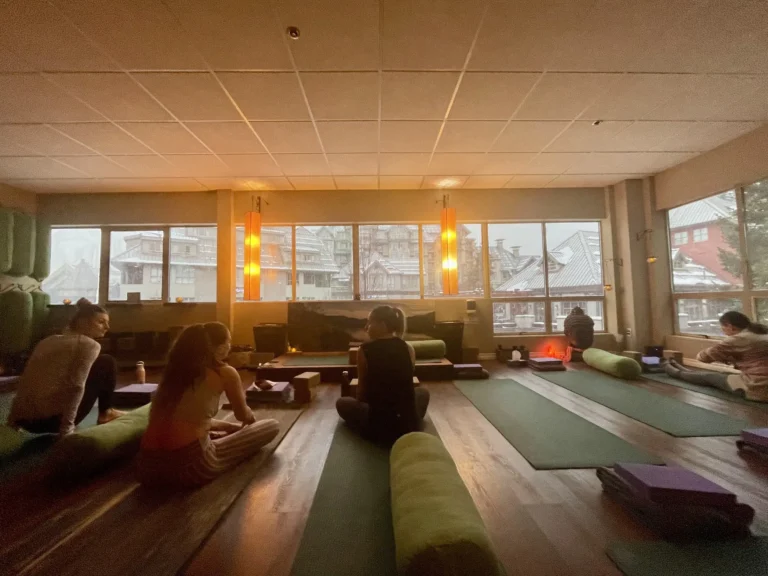Written by Emily Kane – owner and yoga teacher
Skiing and snowboarding is pretty popular this time of year in Whistler Village, especially after a snowfall. Handling powder can be a challenging workout and yet, it still has the qualities of meditation. Its ability to connect you to bliss, nature, yourself and a higher consciousness can make sliding on snow a spiritual experience. The only potential limitation is a body that’s unprepared for the demands, making it difficult to enjoy the ride. So how do you prepare yourself to connect with ease and grace? Snow yoga sequencing can get you ready to take on powder and to start loving pow-days.
My Favorite Snow Yoga Breath: Ujjayi (a.k.a ocean, serpent’s, or victorious breath)
When you’re on a cold chairlift, there’s nothing better to calm your mind and heat your body up than ujjayi breathing. Krishnamacharya, one of the founding fathers of modern yoga, said that ujjayi breathing increases oxygenation and builds internal body heat – perfect for a cold day.
How to:
– Gently tuck your chin and constrict the back of your throat. This creates the “neck lock” a.k.a. Jalandhara bandha
– The constriction should be as if you were fogging a mirror, but with your lips closed. Practicing the breath on your inhalation and exhalation.
– The breath should be audible to you, or even a person next to you, but the sound is subtle enough to maintain a calm awareness of your breath without disturbing your nervous system
You can practice Ujayyi breathing on it’s own in meditation, but it’s also useful during a physical practice. Try ujjayi the next time you’re on a chairlift, or while practicing one of the next poses.
Snow Yoga Pose #1: Chair – Utkatasana
How to:
– Stand in mountain pose (Tadasana) – feet hip distance apart (or together), standing tall with a long spine as you lengthen through the crown of your head
– Exhale to deeply bend knees, weight slightly back into you heels, feet and knees remain parallel
– Inhale reach your arms overhead
– Lengthen your tailbone towards the mat, keep your spine long
– Remain for 10 – 20 breaths, repeat twice
Want to challenge yourself? Try practicing chair and hovering one foot off the ground for 5 breaths then switch your grounding foot.
Anatomical Analysis: Skiing and snowboarding requires strength in the front of your thigh – what’s known as your quadriceps femoris. There are three parts of this muscles including the vastus lateralis, vastus intermedius and vastus medialis (on the outside edge of your front thigh, to most innermost respectively) They insert onto the tibia (lower shin) via your patella (or knee cap) which contributes to the hinging motion of your knee joint. These muscles are important for the extension of your knee and stability when in a squatting position. Skiing and snowboarding requires knees to stay bent for extended periods, or what’s known as an isometric contraction a.k.a. it is from a static position the muscle contracts. Chair pose has a similar static nature and focuses on engaging your quadriceps along with other major muscles groups needed to maintain the contraction without fatiguing.
Snow Yoga Pose #2: Boat Pose – Navasana
How to:
– Come to seated with legs bent in front of you, feet and knees together
– Place palms underneath your knees, inhale to lengthen your spine
– Exhale, lean back over your sit bones while maintaining a long spine
– Inhale, lift your feet in line with your knees (option to straighten your legs, or release your hands to reach outside your knees)
– Keep your shoulders pressed back, chest open and lengthening through the crown of your head
– Remain for 5 – 10 breaths, repeat 2 – 3 times
Anatomical Analysis: Skiing and snowboarding requires strength in the muscles that provide postural support and balance. Activating your transversus abdominus – a deep core stabilizer – will help maintain posture, and improve proprioception or the body’s ability to sense where it is in space. Maintaining a long spine and breathing deeply will connect to this muscle, it will also strengthen the erector spinae (muscles used to lengthen spine) providing additional postural support.
Looking for more ways to improve your skiing and snowboarding experience? Check out our class schedule to find ways to prepare yourself for a day on the slopes.
About the author: Emily Kane is the owner of Yogacara Whistler and a member of the teaching staff. She is a 500 Hour Registered Yoga Teacher with a Bachelor of Kinesiology from the University of British Columbia. Outside of teaching yoga, her passions include snowboarding and the great outdoors. To learn more about Emily and her classes visit Our Yoga Teachers, to learn more about teacher trainings she is co-leading, visit our Yoga Teacher Training page.



